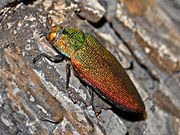Steraspis squamosa: Difference between revisions
No edit summary Tags: content sourced to vanity press Visual edit Mobile edit Mobile web edit |
Insect Mythology should be retained as a source though it is self published, as it's information appears within Haynes book as well, and IM cites academic sources. I am mainly including it because it includes images, unlike Haynes work, which may be of interest to one reading the article and wishing to look more into it's sources. Tags: Visual edit Mobile edit Mobile web edit |
||
| Line 30: | Line 30: | ||
==Cultural Significance== |
==Cultural Significance== |
||
This beetle is likely the particular species of buprestid beetle depicted in ancient Egyptian art. It feeds on the tamarisk tree, boring holes into it for their larvae to pupate. The larvae emerge once mature as beetles. As such was likely identified with Osiris, who was imprisoned in a tamarisk tree in some versions of the myth where he is killed by Set.<ref>{{Cite book |last=Haynes |first=Dawn |url=https://scholar.sun.ac.za/bitstream/10019.1/79920/1/haynes_symbolism_2013.pdf |title=The Symbolism of the Butterfly in Ancient Egypt}}</ref><ref>{{Cite book |last=Kritsky |first=Gene |url=https://books.google.com/books?id=G4quq3rk19cC&pg=PA52&lpg=PA52&dq=hetepheres+buprestid+beetles&source=bl&ots=5YPvW5tlhA&sig=ACfU3U0gKDS1CBk5zK62tQM6XfHRkbhA4Q&hl=en&sa=X&ved=2ahUKEwjf8MqUypOHAxXqhIkEHfmqCuA4ChDoAXoECAIQAg#v=onepage&q=hetepheres%20buprestid%20beetles&f=false |title=Insect Mythology |last2=Cherry |first2=Ron H. |date=2000 |publisher=iUniverse |isbn=978-0-595-15017-5 |language=en}}</ref> |
This beetle is likely the particular species of buprestid beetle depicted in ancient Egyptian art. It feeds on the tamarisk tree, boring holes into it for their larvae to pupate. The larvae emerge once mature as beetles. As such was likely identified with Osiris, who was imprisoned in a tamarisk tree in some versions of the myth where he is killed by Set.<ref name=":0">{{Cite book |last=Haynes |first=Dawn |url=https://scholar.sun.ac.za/bitstream/10019.1/79920/1/haynes_symbolism_2013.pdf |title=The Symbolism of the Butterfly in Ancient Egypt}}</ref><ref name=":1">{{Cite book |last=Kritsky |first=Gene |url=https://books.google.com/books?id=G4quq3rk19cC&pg=PA52&lpg=PA52&dq=hetepheres+buprestid+beetles&source=bl&ots=5YPvW5tlhA&sig=ACfU3U0gKDS1CBk5zK62tQM6XfHRkbhA4Q&hl=en&sa=X&ved=2ahUKEwjf8MqUypOHAxXqhIkEHfmqCuA4ChDoAXoECAIQAg#v=onepage&q=hetepheres%20buprestid%20beetles&f=false |title=Insect Mythology |last2=Cherry |first2=Ron H. |date=2000 |publisher=iUniverse |isbn=978-0-595-15017-5 |language=en}}</ref> |
||
The beetle appears as part of the pins on Queen Hetepheres bed canopy,<ref name=":0" /><ref name=":1" /> and as part of a 6th dynasty broad collar. |
|||
==Gallery== |
==Gallery== |
||
Revision as of 23:49, 6 July 2024
| Steraspis squamosa | |
|---|---|

| |
| Steraspis squamosa | |
| Scientific classification | |
| Kingdom: | |
| Phylum: | |
| Class: | |
| Order: | |
| Family: | |
| Genus: | |
| Species: | S. squamosa
|
| Binomial name | |
| Steraspis squamosa (Klug, 1829)
| |
Steraspis squamosa or the Middle Eastern jewel beetle is a beetle of the Buprestidae family.
Description
Steraspis squamosa can reach a length of about 27–38 millimetres (1.1–1.5 in). These beetles usually have a metallic green or bluish color with orange margin along the edges of the elytra and a rugose surface. They primarily feed on Tamarix, Rhus tripartita and Acacia. They lay the eggs on tree branches and the caterpillars drill hatching holes in the trunk. At the end of the process the insect bursts the bark and a new life cycle begin. The full life cycle last two years. Adult beetles are active in Spring.
Distribution
This species is present in the northern part of Africa, particularly from Red Sea, Sinai, Israel and Egypt to Syria, Mauritania, Algeria and Morocco.
Subspecies
- Steraspis squamosa kindermanni Marseul, 1865
- Steraspis squamosa squamosa (Klug, 1829)
Cultural Significance
This beetle is likely the particular species of buprestid beetle depicted in ancient Egyptian art. It feeds on the tamarisk tree, boring holes into it for their larvae to pupate. The larvae emerge once mature as beetles. As such was likely identified with Osiris, who was imprisoned in a tamarisk tree in some versions of the myth where he is killed by Set.[1][2]
The beetle appears as part of the pins on Queen Hetepheres bed canopy,[1][2] and as part of a 6th dynasty broad collar.
Gallery
-
Steraspis squamosa
-
Steraspis squamosa from Syria, mounted specimen at National Museum (Prague)
-
Steraspis squamosa
References
External links
- ^ a b Haynes, Dawn. The Symbolism of the Butterfly in Ancient Egypt (PDF).
- ^ a b Kritsky, Gene; Cherry, Ron H. (2000). Insect Mythology. iUniverse. ISBN 978-0-595-15017-5.



